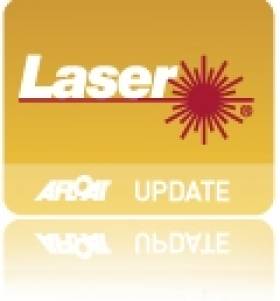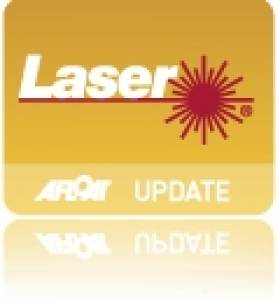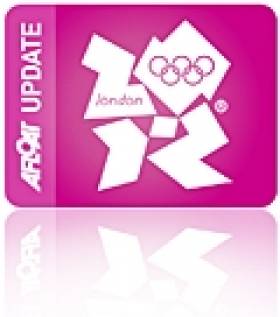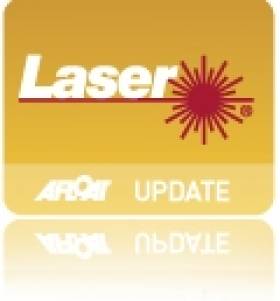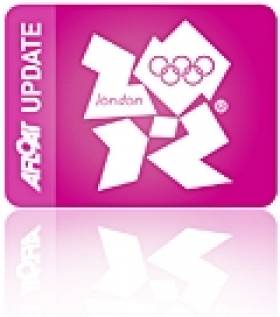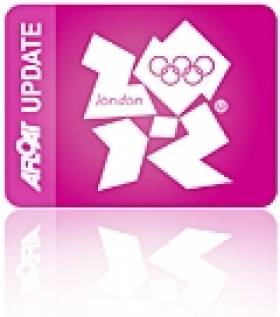Displaying items by tag: Laser
Learn to Sail in a Laser Pico Dinghy For Sale at €1300
#BOATS FOR SALE –The seller of this Laser Pico sailing dinghy could not have picked a better time to put the 12 foot boat up for sale because April is the time of year when Mums and Dads are looking for boats for junior sailing courses. The Laser Pico is a fun, durable, confidence-inspiring, boat that can be sailed by everyone. It's ideal for entry-level sailors and this one has not been used for the past two years.
The rotomoulded Pico is popular at so many sailing schools around the country we don't see this boat for sale for long.
It comes with a launching trailer and the advertiser says it is in great condition, complete with rudder and dagger board. There is a brand new jib. Ideal for beginners or children, easy to manage.
The full Pico advert is here.
See all our dinghies for sale on the Afloat Boats for Sales site here.
UK Laser Sailors in £50K Irish Sea Crossing Challenge
#LASER - A pair of British sailors are set to embark on an intrepid crossing of the Irish Sea using just two single-handed Laser dingies.
David Summerville and Steve Cockerill had originally planned to make the crossing in September last year, but those plans were scuppered by 50-knot gale force winds and a 12-foot tidal swell, according to Incentive Travel.
But the duo is now planning to try again, with the backing of the Ramada Plaza Southport.
“David and Steve will be covering 115 nautical miles during the challenge," said Ramada Plaza general manager Enda Rylands. "They will set off from my own home town of Dublin and finish in Southport, aiming to raise £50,000 for mental health charity Mind and the John Merricks Sailing Trust."
Summerville, a 53-year-old grandfather of two who runs a boat repair business, said the date of the challenge would again depend on weather and tidal conditions, and that the pair is ready to depart any time from mid-April to mid-September.
It's not the first time that an Irish Sea crossing has been done in a Laser as Tiffany Brien achieved the feat in 2010, sailing single-handedly the 30 miles from Portpatrick in Scotland to Belfast Lough.
But Summerville and Cockerill's ambitious undertaking, at more than three times that distance, would surely get them a place in the record books - provided the weather goes their way!
New Laser League for Dublin Bay
#LASER – The single handed Laser dinghy made a welcome return to Dublin Bay racing last year with up to 20 boats racing on a Tuesday evening as part of the regular Dublin Bay Sailing Club (DBSC) season.
And for 2012 it looks like the renewed interest is set to continue with the introduction of the the '2012 Dublin Bay Regatta League' for Lasers.
To encourage participation and bigger fleets Local sailors Paul Keane and Richard Tate have organised the league and participation in the league is free and the winner will have their class Nationals entry fee paid.
The league will work on the ranking system used by the Laser Class with each regatta result counting towards the overall placing.
This year the regatta season runs over 6 consecutive weeks starting with the regatta in the DMYC on the 2nd June, the RAYC on the 16th June, the NYC on 23rd June, the RIYC on the 30th June and finally the RStGYC on the 7th of July.
After an absence of 8 years The Laser Nationals return to Dublin Bay in August 2012. The event will be hosted by the NYC and with strong local fleets a big turnout can be expected.
Click here to find out more.
Espey Plans Belfast Olympic Fundraiser
#OLYMPIC – Ballyholme and Royal Ulster Yacht Club sailor, James Espey has been campaigning to go to the Olympics in Weymouth this summer. As part of his campaign he is hosting a Fundraising Day on Saturday 18 February at BYC. This will include a day of coaching and racing, then and an evening party. The coaching will be taken by James himself and a guest coach. Top Laser sailors will be racing – come along and pace yourself against the best Laser sailors in the Northern Ireland.
In the evening there is a great party planned – Dinner and Cocktails, an Olympic auction and entertainment with music. Come along to support 'Bapsy' and send him on his Olympic journey.
James will be competing in Germany at the Laser Worlds and this is the event he is anticipating to qualify for the Games.
Saturday, 18 February
Laser Coaching 1130-1300hrs
Lunch 1300-1400 (Soup & Rolls)
Laser Racing 1400 – 3 races
Dinner & Cocktails 1900hrs
Auction @ 2030
Tickets for the full day are £30, £15 for the evening dinner and entertainment
Howth Laser Frostbite Inter-Club Laser Masters Challenge
#LASER – All Master Laser sailors are invited to compete in the second running of the Laser Inter-club Masters' Challenge being held by Howth Yacht Club on Saturday 10th March as the finale to the Laser Frostbite Series.
All Masters Laser sailors are invited to enter teams (3 minimum) to compete for the trophy. The event consists of 3 races (two windward-leewards, each approx 40 mins. duration, and the Round the Island Race), with the first race starting at 10:55. The best three Masters sailors from each club will count for the trophy.
The famous Howth Laser Lunch and prize-giving will follow straight after racing. The Ireland V Scotland game will be shown on big screens after the lunch in the club bar.
More details from Howth Yacht Club.
Irish Sailors Fight for Medal Race Rights in Miami
#MOCR – A place in this weekend's medal race is the likley prize for Olympic Star keelboat pair Peter O'Leary and David Burrows who have scored top ten results for the third day in a row at the Miami Olympic Classes Regatta. The Cork–Dublin duo, now in seventh overall after a seventh and a sixth scored yesterday, need to continue the consistent performance into today's final round of fleet racing to secure a top ten placing overall.
Dun Laoghaire's single-hander Annalise Murphy in the Laser Radial now in ninth overall is also set for a place in Saturday's medal race having discarded her worst result of 27th, scored yesterday afternoon on Biscayne Bay.
The Irish Paralympic team in the Sonar class had their best day so far of the championship with two fifth places. A protest yesterday evening resulted in their disqualifcation from yesterday's final race but that didn't prevent them from moving up one place on the leader board to seventh overall.
Laser sailor James Espey from Belfast Lough slipped to 22nd overall following two 35th places.
Additional reporting by organisers:
Miami, Florida, USA: A final showdown awaits three Paralympic classes tomorrow and ten Olympic classes on Saturday at US Sailing's Rolex Miami OCR, which has, thus far, gifted sailors with four days of sublime sunshine and satisfying winds. The event is the only one of seven ISAF Sailing World Cup events to grace a shore on this continent and has attracted 529 sailors from 41 countries from as close as Canada and as far away as New Zealand and China.
"It's looking pretty exciting," said Brazil's Star sailor Robert Scheidt, who with crew Bruno Prada has perhaps one of the most impressive sailing records here. (Together, they are two-time Olympic medalists and just off their second straight title win at the Star World Championships). "Some of the guys who have already got a spot in the Olympics are here and they are really sailing well."
No one has been proving that theory better than Sweden's Fredrik Loof/Max Salminen who yesterday trailed Scheidt/Prada by two points and today tied on points with the Brazilians after finishing 6-2 to their 3-7. With both teams posting 26 points, Norway's Eivind Melleby/ Petter Moerland Pedersen are nipping at their heels with only 29 points.
As will happen at the Olympics, only the top-ten boats after tomorrow's racing will be allowed to progress to Saturday's single medal race, which will determine gold, silver and bronze medals.
For the Paralympic sailors here, tomorrow will be the final day of racing (two races each scheduled for Skud-18, Sonar and 2.4mR classes) and determine who takes home medals. (This is the same format that will be followed at their Games.)
Top three podium positions:
Sonar, 10 boats, - 8 races
1. Jourden Bruno / Vimont Vicary Nicolas / Flageul Eric, FRA, 19 points
2. Udo Hessels / Marcel van de Veen / Mischa Rossen, NED, 20
2. John Robertson / Hannah Stodel / Steve Thomas, GBR, 22
Star, 29 boats, - 8 races
1. Robert Scheidt / Bruno Prada, BRA, 26
2. Fredrik Loof / Max Salminen, SWE, 26
3. Eivind Melleby / Petter Moerland Pedersen, NOR, 29
49er, 23 boats, - 12 races
1. Nico Luca Marc Delle Karth / Nikolaus Resch, AUT, 29
2. Erik Storck / Trevor Moore, USA, 33
3. Allan Norregaard / Peter Lang, DEN, 61
Skud-18, 6 boats, - 8 races
1. Daniel Fitzgibbon / Liesl Tesch, AUS, 13
2. Alexandra Rickham / Niki Birrell, GBR, 13
3. Jennifer French / Jean-Paul Creignou, USA, 20
2.4mR, 25 boats, - 8 races
1. Damien Seguin, FRA, 13
2. Paul Tingley, CAN, 33
3. Megan Pascoe, GBR, 39
Laser Radial, 60 boats, - 8 races
1. Lijia Xu, CHN, 19
2. Marit Bouwmeester, NED, 25
3. Evi Van Acker, BEL, 38
470 Men, 22 boats, - 8 races
1. Mathew Belcher / Malcolm Page, AUS, 20
2. Sven Coster / Kalle Coster, NED, 24
3. Lucas Calabrese / Juan Maria de la Fuente, ARG, 32
470 Women, 15 boats, - 8 races
1. Lisa Westerhof / Lobke Berkhout, NED, 22
2. Hannah Mills / Saskia Clark, GBR, 23
3. Maria Fernanda Sesto / Consuelo Monsegur, ARG, 31
Laser, Gold,, 37 boats,- 8 races
1. Paul Goodison, GBR, 15
2. David Wright, CAN, 17
3. Bruno Fontes, BRA, 18
Laser, Silver,, 37 boats,- 8 races
1. Marcin Rudawski, POL, 100
2. Ricardo Montemayor, MEX, 103
3. Matthew Ryder, CAN, 114
Finn, 25 boats, - 8 races
1. Zach Railey, USA, 9
2. Jonas Hogh Christensen, DEN, 19
3. Brendan Casey, AUS, 25
RS: X Men, 14 boats, - 8 races
1. Nick Dempsey, GBR, 7
2. Elliot Carney, GBR, 19
3. Mariano Reutemann, ARG, 20
RS: X Women, 12 boats, - 6 races
1. Demita Vega De Lille, MEX, 10
2. Carolina Mendelblatt, POR, 21
3. Farrah Hall, Annapolis, Md., USA, 22
Women's Match Racing
TOP FOUR ADVANCING TO SEMIFINALS
Sally Barkow / Alana O'Reilly / Elizabeth Kratzig-Burnham, USA, 3 wins- 0 losses
Silja Lehtinen / Silja Kanerva / Mikaela Wulff, FIN, 3 wins- 0 losses
Olivia Price / Nina Curtis / Lucinda Whitty, AUS, 3 wins- 0 losses
Lucy Macgregor / Annie Lush / Kate Macgregor, GBR, 3 wins- 2 losses
Irish Olympic Sailors Score 11,13 in Miami
#RMOCR – Ireland's Star and Laser Radial sailing teams stay in the top third of their respective fleets after the first day of racing at the 2012 Rolex Miami Olympic Classes Regatta but only just. After a mixed opening day's performance from Peter O'Leary and David Burrows the keelboat pair are 11th from 33. Annalise Murphy fares better in13th after two races from a fleet of 60 boats competing on Biscayne Bay.
The sailors are Ireland's best hopes for a sailing medal at the London Olympics and are funded by the Irish Sports Council.
Conditions on the blustery Florida race courses, often judged to be one of the best race tracks in the world, blew from the north east and 12-20 knots in strength across the five courses. Over 700 sailors are competing, drawn from over 50 countries and ten Olympic classes.
It's the second round of ISAF's Sailing World Cup Regatta and as such represents one of the most important build up regattas of the year in advance of the Olynpic Games in less than 200 days time. Both Irish crews, who qualified for London in Perth last December, are fighting hard to post consistent results but yesterday's opening two rounds, although solid performances, wil not be the post Christmas boost they were looking for.
The Irish keelboat took a yellow flag Yellow flag penalty in the first race and did well to get back to tenth O'Leary and Burrows scores of 10th and a 12th place them 11th overall.
Annalise Murphy concluded the day in 13th overall having secured a 17th and a 19th in her two races of the day.
Independent non-carded sailor James Espey got off to a consistent start in the largest of the classes, the 78 boat Laser fleet. He sits just outside the top 10 at 11th overall having finished 12th in both of his races of the day.
Also competing are the Irish Paralympic sailors John Twomey, Anthony Hegarty and Ian Costello in the Sonar class. The trio lie in the middle of the 11 boat fleet at 6th overall following a 9th and a 4th in their two races.
Black Flag Rules Out Espey's Perth Qualification Hope
#PERTH2011 – A black flag result for Ireland's Laser sailor James Espey ruled out any chance of Olympic qualification in Perth today even though the Belfast single-hander was on the cusp of qualifying going in to today's final rounds.
He finished 38th nation with only the top 35 nations going through to London 2012. He has a further chance at the Laser World Championships in Germany but that is not until May.
Mixed Olympic Results from Melbourne Warm Up
#OLYMPIC SAILING–As the important Olympic sailing Qualifier event in Perth, Australia draws closer Ireland had Laser, Laser Radial and 49er teams competing in Sail Melbourne as a warm up event last week.
49er dinghy men Ryan Seaton and Matthew McGovern took six third places over a series of 14 races to finish fourth in their seven boat fleet.
Dun Laoghaire's Annalise Murphy from the National Yacht Club, a medal hope for Ireland in London next year, was ninth from 25 starters, second being her best individual race score in race eight of here ten race series. She finished eighth in the final medal race.
Belfast Lough's James Espey from Royal Ulster YC made the gold fleet in the Laser class finishing 27th from 32.
Cork Laser Sailors Win in Grafham and Dun Laoghaire
In the Radial Class, Séafra Guilfoyle was fourth in a fleet of 120 boats and the winner of the Under 16 section. Dermot Lyden finished 74th in his first international event in this class.
At the National Yacht Club on Dublin Bay, another Royal Cork helm Patrick Crosbie won the National 4.7 Squad Trials in a fleet of over 20 boats. Following Patrick were Ross O'Sullivan and Sorcha Ní Shuilleabháin from Kinsale Yacht Club making it 1-2-3 for the Munster club.



























